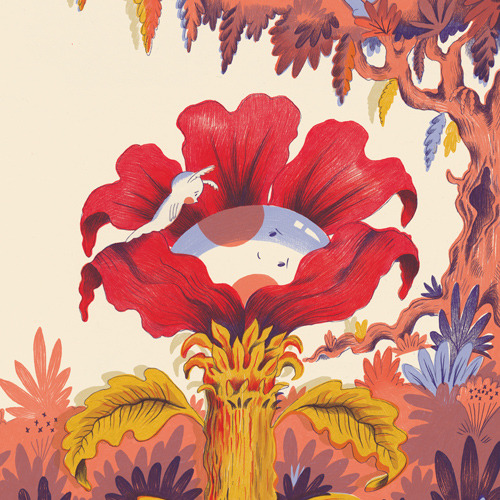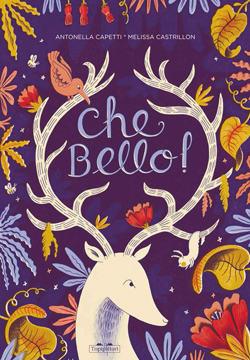< Back to posts
Melissa Castrillón
United Kingdom

Melissa Castrillón studied at Cambridge School of Art, where she achieved a First Class honours degree in Illustration and a Masters in Children’s Book Illustration. Since graduating, she’s worked on a wide range of projects, such as interior design, posters, packaging, book covers, editorial and picturebooks. Melissa lives in Cambridge.
In this post, Melissa talks about illustrating her second picturebook, ‘Che Bello!’ (How Beautiful!). This engaging story about a caterpillar seaching for the meaning of the word ‘beautiful’ was written by Antonella Capetti and is published in Italy by Topipittori.
Visit Melissa Castrillón’s website
Visit Melissa Castrillón’s Instagram page
Melissa: ‘Che Bello!’ is my second illustrated picturebook, beautifully written by Antonella Capetti and published by Italian publisher Topipittori. I knew that the marriage of her forest world and my botanically-inspired illustrations would be a really enjoyable adventure to go on.
That book adventure started off with me experimenting with flowers, plants and colour. From the get-go I had a pretty clear idea of the colour palette I wanted to use. Sometimes it happens that the colour comes before the image development; I think because colour is such an important and key part of my work, it can fall into place straight away. This consciousness of colour is also aided by my love of screen printing and the process of printing in layers of block colour. When preparing a screen print, I have to think about which colours will go best together early on.
The second stage was to play with composition. I have, huge, HUGE love and respect for designers and makers who can use inventive compositions and shapes to frame the words – and in the process make the text and image flow as one whole, rather that having words plonked on a page with no thought as to how they interact or compliment each other. To merge the text and image I often experiment with negative space, which I’ve done a lot for this book. To do this, I find a key piece of imagery – such as a hand, a squirrel’s tail, or the space in-between some leaves – and then play around with incorporating the text within that. It’s so, so satisfying to see and make a book where the image and text are intertwined both in the design and in the narrative.
Narratively, it’s important for me to produce illustrations which aren’t just depicting what’s said in the text, but where they show what’s not said, opening up the world even more to the reader.
For composition inspiration, I often turn to pattern-makers such as textile designers and ceramic artists. I can find myself on Pinterest for hours at a time looking at early-to-mid-20th century wallpaper designs, mugs, plates and textiles because I’ll often find a killer use of pattern and organic shapes, which can be really helpful for me when I’m designing the page.
I was so excited when I discovered the work of early 20th century Swedish textile designer Josef Frank. His bright, bold botanical textiles with an unusually vibrant colour palette for that era definitely inspired the first page of the book, which can be seen in the bold leaf shapes and spiralling vines.
Textile designs by Josef Frank.
The challenges I faced with this book were definitely in areas I’m less confident in, mainly character design. I often struggle with showing emotion in my sketches and it was no different here with the little protagonist. I spent quite a while drawing the caterpillar with a mouth, but it looked way too cute, slightly creepy, too happy or just plain confused. So I decided that it wasn’t going to have a mouth. I had to have another way of showing emotion, and the addition of furry antennae – which could droop when sad and stand straight up when surprised – meant I could get away with it.
Another character which I had trouble with was the camel, which was originally written into the story but later on became a deer. Camels are lumpy, bumpy animals and hard to draw not looking awkward, especially when lounging on a chaise longue. I found myself drawing the camel as a deer, which visually worked a lot better. I was worried that the author Antonella would be upset about the change, so it was a relief when Paolo from Topipittori said she was more than willing. So thank you, Antonella! It worked out perfectly, especially as the deer is on the front cover.
Screen printing is my all-time love and has influenced how I plan and make my illustrations. All of my illustrations are one to five colours and drawn up as different layers, which are finally merged onto one page to form the complete illustration.
The only difference between me making a screen print and making the artwork for ‘Che Bello!’ was the last stage: the colour, which was done on the computer.
In the case of ‘Che Bello!’, every illustration is a five-colour image. I drew out each colour using a fine 0.7 HB mechanical pencil for maximum mark-making, using a light pad to line up each layer before drawing. I then scan in each layer and, rather than hand-ink each layer as I would with a screen print, I digitally colour and combine each layer in Photoshop. My heart will always have a special place for traditional printing though; it’s just much more fun to do everything by hand!
I’m currently working on my first authored picturebook (published in 2019 with Alison Green Books) which will be printed in three Pantone colours overlapping to produce six colours. I’m hoping this will be the perfect balance between screen printing and digital. Fingers crossed!
Illustrations © Melissa Castrillón.
Che Bello! / How Beautiful!
Antonella Capetti & Melissa Castrillón
Topipittori, Italy, 2017
Extraordinary things can happen in the life of a little caterpillar. One morning, while he’s busy doing his usual things, he meets a mysterious being who tells him a brand new word. He can’t stop thinking about this word, and goes around the forest, asking the animals if they know what it means.
However, answer after answer, things get even more confusing. Just when the caterpillar is about to give up hope, something happens in the night sky...
















